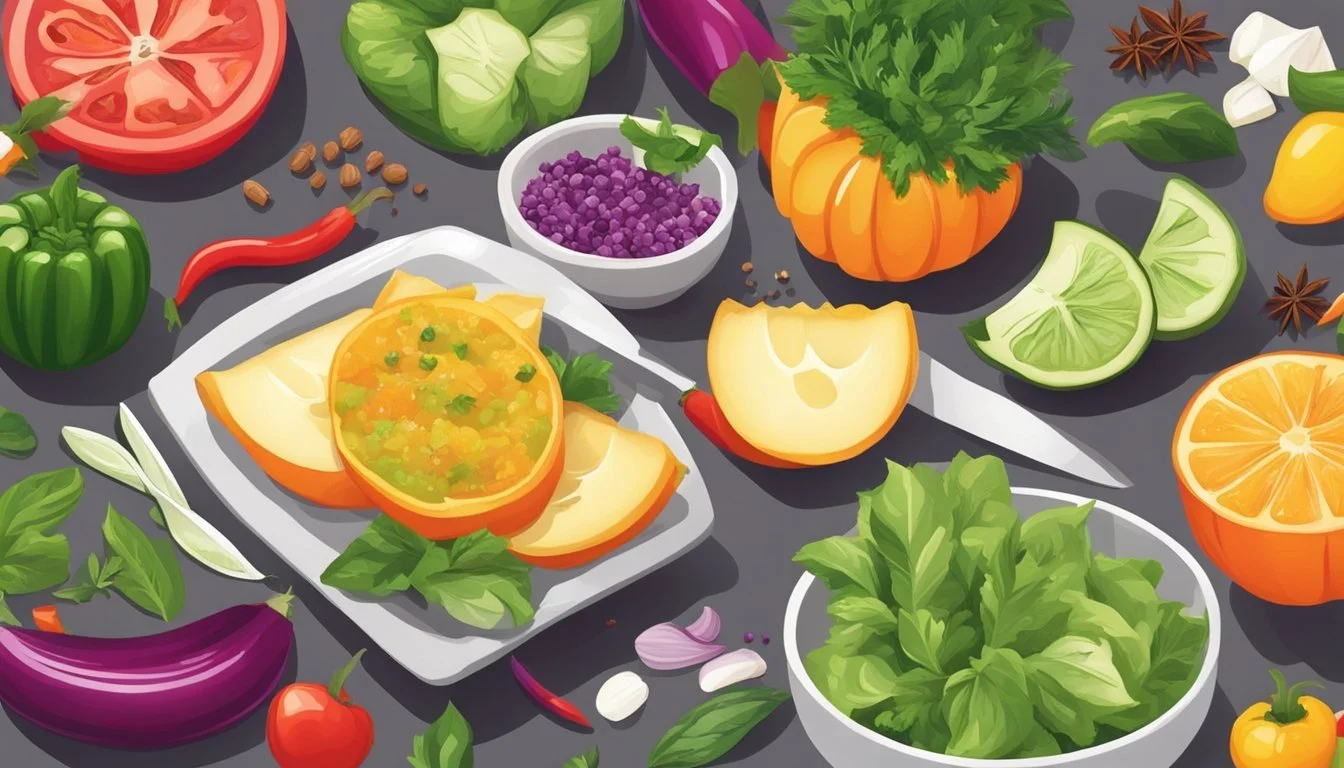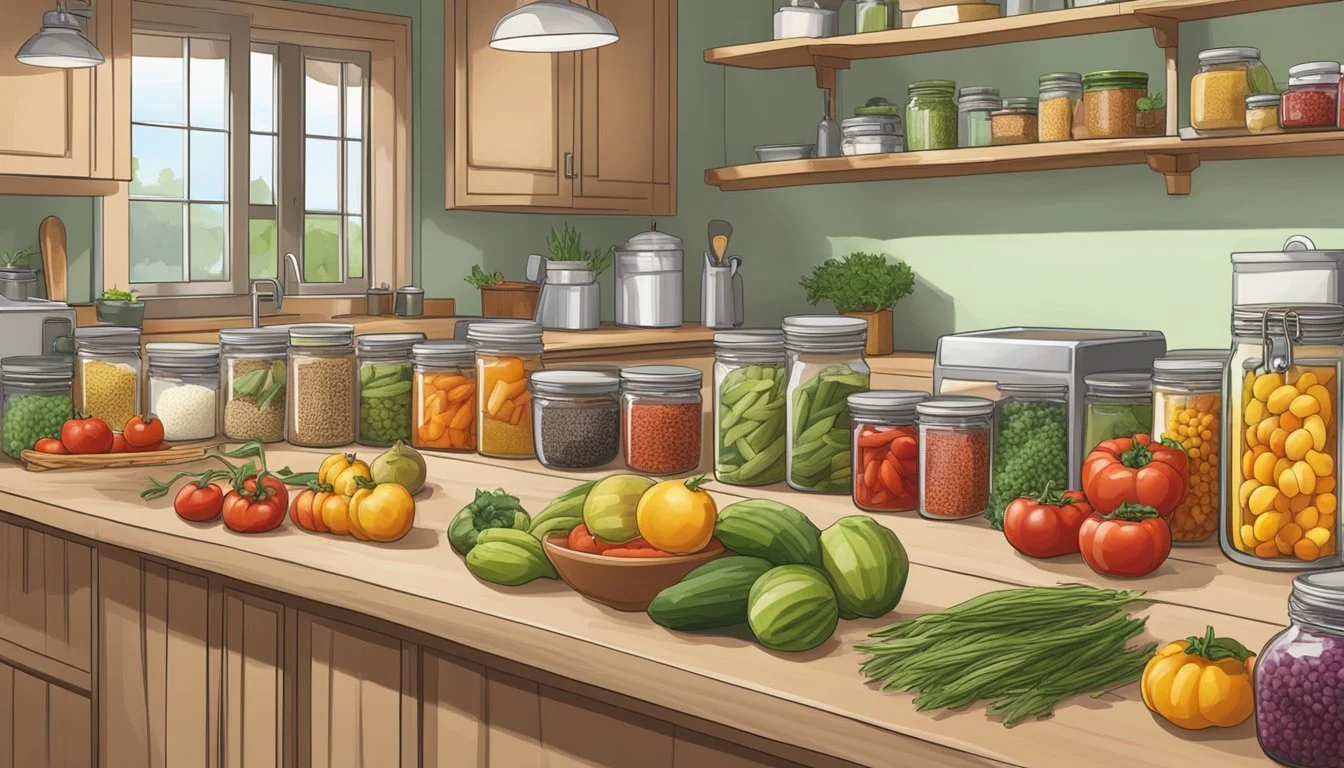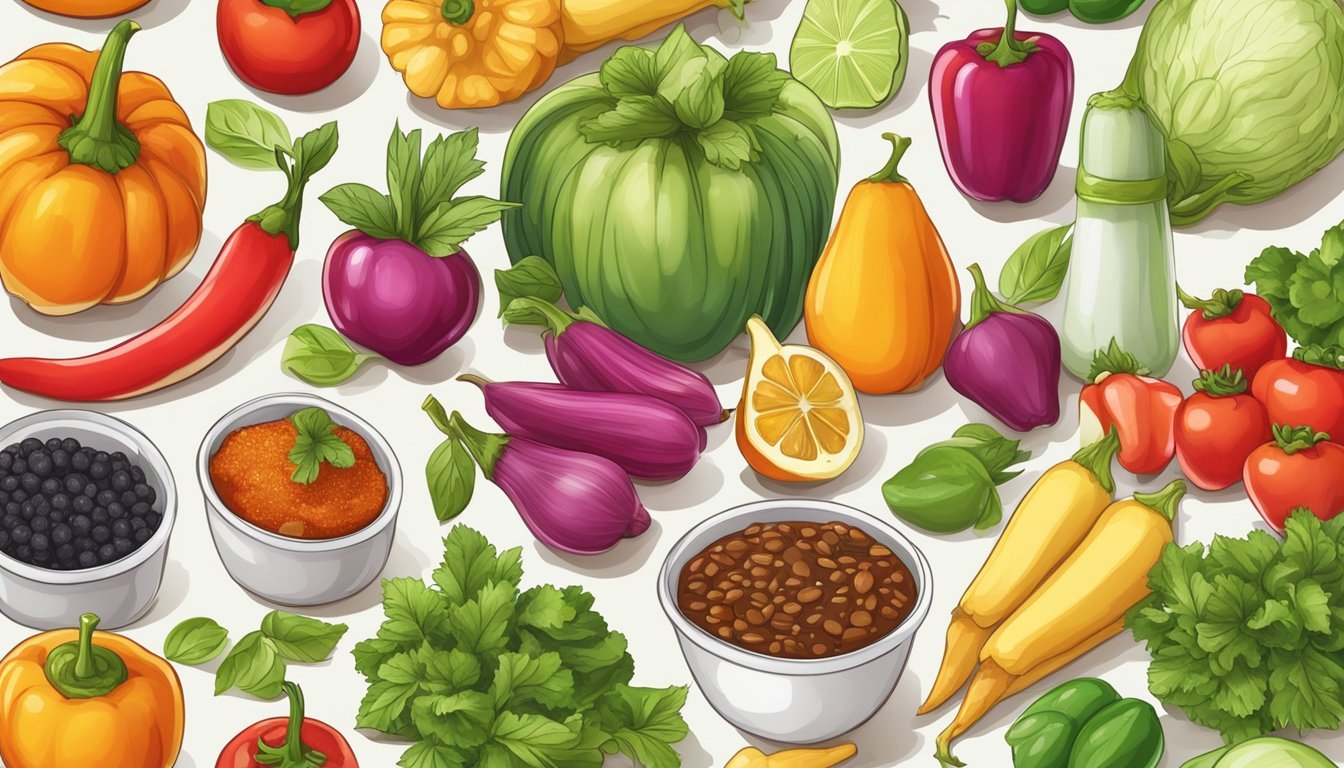Swicy and Seasonal
Mastering the Art of Sweet-Spicy Recipes with Fresh Produce
The combination of sweet and spicy flavors, colloquially termed 'swicy', has emerged as a culinary trend that engages the palate in a complex dance of sensations. As chefs and home cooks alike explore this fusion of taste, they are turning to fresh, seasonal produce to anchor these bold flavors. By incorporating fruits and vegetables at their peak, dishes gain not only the vibrant tastes that come from using high-quality, in-season ingredients, but also a natural sweetness that complements the heat.
Utilizing seasonal produce to craft sweet-spicy dishes (What wine goes well with spicy dishes?) not only enhances flavor profiles but also aligns with a growing movement toward sustainability and health-conscious eating. Ingredients like ripe berries, stone fruits, and crisp peppers provide the perfect canvas upon which the swicy concept can flourish. Whether blending the fiery kick of chili with the mellow sweetness of mango or creating a robust glaze by combining honey with hot mustard, these flavor combinations are as versatile as they are enticing.
The intersection of sweet and spicy elements in cooking is not new; however, the deliberate spotlight on this combination reflects a broader culinary shift towards more adventurous eating. Innovative swicy combinations can elevate a dish from ordinary to extraordinary, offering a symphony of tastes that can enhance both the nutritional value and the overall dining experience. Through thoughtful pairings of sweetness and spice, cooks are transforming how we approach the fusion of flavors in modern cuisine.
The Foundation of Sweet and Spicy Cuisine
The allure of sweet and spicy cuisine lies in the harmonious convergence of contrasting flavors, engaging a full range of taste sensations. This balance, when achieved correctly, offers a satisfying complexity to dishes.
Understanding the Balance of Flavors
Every sweet and spicy dish begins with a fundamental understanding of how flavors interact. Sugar and spices combine to elevate the taste experience. Sugar mellows the heat from spicy elements, while spices, such as chile flakes or ground pepper, intensify the depth and richness of sweet ingredients. Salt and acid are often included to create a full-bodied flavor profile. The key to mastering sweet and spicy cuisine is ensuring no single flavor overpowers another.
Selecting Your Proteins
The choice of protein serves as a canvas for sweet and spicy creations. Chicken, particularly chicken breast, is a lean and versatile option that readily absorbs these flavors. It's essential to balance the seasoning, using the sweetness to complement the innate savoriness of the meat. For a richer taste, ground beef can be used, with its fat content providing a counterbalance to the heat of spices like garlic and red pepper flakes.
Choosing the Right Vegetables
Vegetables add texture, color, and nutritional value to sweet and spicy dishes. Selections such as onions, carrots, bell pepper, and broccoli offer varying degrees of sweetness and can withstand the boldness of spicy seasonings. For a finishing touch, green onions provide a crisp, mild flavor that contrasts with the underlying heat. Utilizing fresh, seasonal vegetables enhances both the taste and visual appeal of the dish.
Preparation Techniques for Optimal Flavor
Perfecting the swicy (sweet and spicy) flavor profile involves careful selection and preparation of ingredients. The key lies in balancing the natural sweetness of fresh, seasonal produce with the heat of spices, all while using techniques that enhance their inherent characteristics.
Creating Sweet and Spicy Marinades
To craft a marinade that delivers a harmonious blend of swicy flavors, one should start with a base of soy sauce for umami depth and water to balance concentration. Incorporating brown sugar or honey imparts a smooth sweetness that complements the heat. Aromatic components such as minced garlic and grated ginger add complexity. To introduce the spicy aspect, dashes of red pepper flakes, cayenne pepper, or finely chopped jalapeno can be adjusted for desired heat levels.
Soy sauce: 1/4 cup
Water: 1/4 cup
Brown sugar or honey: 2 tablespoons
Fresh garlic (minced): 2 cloves
Ginger (grated): 1 tablespoon
Red pepper flakes/cayenne pepper/jalapeno: to taste
Allowing the produce or protein to sit in the marinade for at least an hour before cooking will not only infuse it with flavor but also tenderize it, making for a more succulent dish.
Cooking Methods for Sweet and Spicy Dishes
Each cooking method can affect the taste and texture of the swicy dish differently. Stir-frying in a high-heat wok allows for rapid cooking, which is ideal for crisp-tender vegetables and meat, sealing in the sweet-spicy glaze. Baking and roasting in an oven offer a gentler approach, caramelizing the sugars in the marinade while softening the ingredients and deepening their flavors. Grilling over an open flame provides a smoky dimension that pairs exceptionally well with the swicy taste. In contrast, braising in a covered pot over low heat gives way to a more mellow spice, as ingredients slowly simmer and absorb the sweet and spicy liquids.
In each case, the cook should monitor the cooking process to ensure that the sugar in the dish does not burn, while also allowing enough time for the heat from the spices to mellow and meld with the other flavors, achieving an optimal swicy balance.
Signature Sweet-Spicy Recipes to Try
This section showcases recipes that perfectly blend the heat of spices with the natural sweetness of fresh produce, providing a delightful taste experience.
Sweet and Spicy Chicken Delights
Sweet and Spicy Chicken: A satisfying dish where chicken breast is marinated with a fusion of honey, soy sauce, and red pepper flakes for a perfect balance of sweet and heat. It’s typically sautéed until golden and served over a bed of white rice or nutrient-rich quinoa. (What wine goes well with quinoa?)
Ingredients:
Chicken breast
Honey
Soy sauce
Red pepper flakes
Brown rice or quinoa
Pineapple Chicken: Juicy pieces of chicken are combined with chunks of pineapple, adding a tropical sweetness that complements the zing of fresh ginger and jalapeño. This dish pairs excellently with brown rice, which absorbs the sauce and adds a whole grain punch.
Ingredients:
Chicken
Pineapple
Ginger
Jalapeño
Brown rice
Innovative Twists on Classic Sides
Quinoa with Almonds and Jalapeño: A side that brings a nutritious twist to the table, this quinoa dish is tossed with toasted almonds for crunch and diced jalapeño for a pop of heat.
Ingredients:
Quinoa
Almonds
Jalapeño
Cayenne-Spiked Honey Glazed Carrots: Carrots take on a new personality when roasted with a honey glaze that's spiced up with cayenne pepper, striking a balance between earthy sweetness and a warm kick.
Ingredients:
Carrots
Honey
Cayenne pepper
Pineapple Salsa: An invigorating side, combining the sweetness of pineapple with the fire of red pepper flakes, this salsa works beautifully atop grilled chicken or as an accompaniment to crunchy tortilla chips.
Ingredients:
Pineapple
Red pepper flakes
Other salsa components (tomatoes, onions, cilantro, lime juice)
Each recipe leverages seasonal produce to enhance both flavor and nutrition, showcasing that sweet and spicy combinations can be both delicious and wholesome.
Infusing Sweet-Spicy Flavors into Snacks
Snack time is an opportunity to experiment with taste, and infusing sweet-spicy flavors can turn simple ingredients into extraordinary snacks. This section provides recipes to elevate nuts and party appetizers with a blend of sugar and spice.
Homemade Spiced Nuts Variations
For lovers of sweet and spicy nuts, creating a homemade mix is a satisfying project. A basic recipe starts with selecting an assortment of nuts including cashews, pecans, and almonds. Coating these nuts with a whisked egg white, followed by a dusting of granulated sugar, sea salt, cinnamon, chili powder, and paprika, ensures an even layer of flavor. Roast the coated nuts in the oven at 350 degrees Fahrenheit until they are dry and crispy, for about 10 to 15 minutes.
Here's an example of how to customize a sweet-spicy nut mix:
Nut Type Sugar (1 cup nuts) Spices (1 cup nuts) Egg White (1 cup nuts) Baking Time Cashews 2 tbsp 1/2 tsp chili powder 1 10-15 min Pecans 2 tbsp 1/2 tsp cinnamon 1 10-15 min Mixed Nuts 2 tbsp 1/4 tsp paprika, 1/4 tsp sea salt 1 10-15 min
Creative Sweet-Spicy Party Appetizers
Transforming classic party appetizers (What wine goes well with appetizers?) What wine goes well with appetizers? with sweet-spicy elements can captivate guests' palates. Consider meatballs glazed with a sticky sauce infused with chili powder and a hint of brown sugar. Another idea involves skewered pieces of fruit and cheese drizzled with a hot honey reduction, mingling spicy and sweet in one bite.
For an interactive appetizer, serve a fondue with options for dipping; dark chocolate paired with spicy seasonings can surprise the taste buds. Sweet and spicy-themed snack boards can include an assortment of spiced nuts, alongside slices of spicy chorizo and sweet dried fruits. When preparing these dishes, it's essential to balance the sweetness and heat to cater to various preferences, ensuring that all guests have an enjoyable snacking experience.
Preserving and Storing Sweet-Spicy Creations
Creating sweet-spicy dishes like salsa and stir-fry with fresh produce can be a delightful experience. Preserving their flavors for future enjoyment or gifting to neighbors requires specific techniques to maintain their taste and integrity.
Freezing Techniques for Longevity
When it comes to extending the shelf-life of sweet and spicy creations like stir-fry or salsa, freezing is an excellent option. The key is to cool the dishes quickly after cooking to retain freshness. Here's how:
Stir-fry: Allow the stir-fry to cool, then transfer it to a freezer-safe bag or container. Remove as much air as possible before sealing to prevent freezer burn.
Salsa: Pour cooled salsa into ice cube trays or small containers, leaving some room for expansion as it freezes. Once solid, transfer the cubes to a sealed bag for easy portioning.
Freezing roasted or homemade spiced nuts requires a simple process:
Nuts: After cooling, spread the nuts in a single layer on a baking sheet to freeze individually.
Once hard, place them into airtight containers, separating layers with parchment paper.
Proper Packaging for Gifting
Packaging sweet and spicy treats such as homemade spiced nuts requires care to ensure they remain fresh and presentable:
Homemade Spiced Nuts: Place cooled nuts in decorative jars or cellophane bags tied with a ribbon. Include a label with the date of preparation and ingredients used.
Salsa: Opt for sturdy jars with tight-fitting lids. Consider adding a fabric topper for a rustic touch.
For both, make sure the packaging material is food-safe and moisture-resistant to maintain the quality of these palate-pleasing gifts.
Health Considerations and Dietary Adjustments
When creating swicy dishes with fresh produce, careful consideration should be given to dietary restrictions and nutritional balance. The incorporation of specific ingredients can provide flavorful alternatives while addressing health concerns such as high sodium and sugar intake.
Reducing Sodium and Sugar
Sodium Reduction: Traditional swicy recipes often call for soy sauce, which is high in sodium. To decrease sodium content, one can opt for low sodium soy sauce, Bragg's Liquid Aminos, or coconut aminos as alternatives with a similar umami profile.
Sugar Adjustments: Instead of using refined sugars, dishes can benefit from the natural sweetness of carrots or peas. When additional sweetness is needed, brown sugar can be used sparingly or substituted with natural sweeteners to manage sugar intake.
Gluten-Free and Vegan Options
Gluten-Free Alternatives: For those avoiding gluten, soy sauce can be replaced with a gluten-free variant. Thickeners like corn starch are already gluten-free, making them suitable for creating the sauce's desired consistency.
Vegan-Friendly Ingredients: To cater to vegan diets, animal products can be replaced with plant-based proteins such as chickpeas, which offer both texture and nutrition. The heat element can derive from cayenne pepper or sliced jalapeños, which provide robust spice without any animal derivatives.
By considering these dietary adjustments, vibrant swicy dishes can be crafted to cater to a range of health-conscious preferences while maintaining the balance between sweet and spicy flavors.
Sweet and Spicy Fusion: Global Influences
The culinary trend of merging sweet and spicy flavors is evident across various cuisines globally, creating a symphony of tastes that titillate the palate.
Asian Inspired Sweet-Spicy Dishes
Asian cuisine often employs a rich palette of ingredients to craft dishes that exemplify the sweet-spicy fusion. Ginger and soy sauce, staples in Asian cooking, lend themselves to multiple preparations. Dishes like Korean-inspired stir-fry often incorporate honey and green onions with a hint of heat from jalapenos or chili flakes, leading to a delectable balance of flavors. Stir-fry scenarios frequently involve a sweet element like honey or sugar that is expertly counterbalanced by the depth and spiciness of fresh ginger and soy sauce, simmered together and poured over crisp vegetables and tender proteins.
Latin American Heat Meets Sweet
Latin American cuisine merges the heat of jalapenos and other chili peppers with the natural sweetness found in fruits and salsas. Pineapple salsa, enriched with cilantro and occasionally spiked with hot sauce, exemplifies the sweet-spicy duality celebrated in this culture. This fusion is often seen in tacos and grilled meats, where the vibrant heat of the jalapeno is mellowed by the addition of sweet elements, allowing the diner to experience both flavors without being overwhelmed by the intensity of the spices.
Tips and Tricks: Elevating Your Sweet and Spicy Meals
When crafting sweet and spicy dishes, the right balance of heat, sweetness, and freshness can transform the ordinary into the extraordinary. Condiments and garnishes play a pivotal role, as do complementary drink pairings.
Enhancing Flavors with Condiments and Garnishes
Garlic and Onions: Sauteed garlic and onions form a savory base that magnifies the complexity of sweet-spicy dishes.
Green Onion: Chopped green onion introduces a crisp, fresh note when sprinkled atop finished dishes.
Honey: Drizzled honey not only adds sweetness but also a sticky glaze that pairs well with the heat from spices like red pepper flakes.
Cilantro: Fresh cilantro leaves provide a citrusy accent, cutting through the richness and pairing well with acidic components.
Acidity: A squeeze of citrus or a dash of vinegar can brighten dishes, balancing the deep flavors of sweet spices and heat.
Garnish Table:
Garnish Effect on Dish Recommended Pairing Sauteed Garlic Intensifies base flavors Pineapple-based sauces Green Onion Adds freshness and crunch Black pepper-rich dishes (What wine goes well with rich dishes?) Honey Sweetens and glazes Red bell pepper stir-fries Cilantro Leaves Gives a burst of herby, citrusy refreshment Red pepper flake spiced dishes A dash of Acid Cuts richness, elevates flavor complexity Sweet-spicy meat glazes
Perfect Pairings: Drink and Sweet-Spicy Food Matches
Red Bell Pepper and Pineapple Salsa: A sweet Riesling contrasts beautifully against this salsa's sweetness and subtle kick.
Spicy Garlic Chicken: Consider a creamy lassi or milk-based drink to temper the heat and complement the garlic.
Black Pepper Tofu: A tangy lemonade refreshes the palate and enhances the sharpness of black pepper.
Drink Pairings Table:
Dish Beverage Match Effect Spicy Salsa Sweet Riesling Balances heat with fruity notes Garlic Chicken Creamy Lassi Cools the palate, contrasts spice Pepper Tofu Tangy Lemonade Cuts through richness, refreshes
Pairings should enhance the dining experience without overpowering the dish's primary flavors. The key is to select drinks that complement the spicy and sweet elements on your plate.









